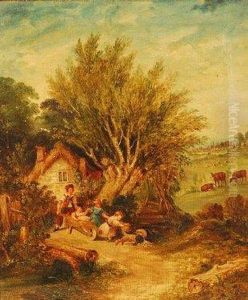Edwin Landseer Lutyens Paintings
Sir Edwin Landseer Lutyens was a British architect known for imaginatively adapting traditional architectural styles to the requirements of his era. He designed many English country houses, war memorials, and public buildings. Born on March 29, 1869, in London, Lutyens was named after his father's friend, the painter Sir Edwin Landseer. He grew up in a creative environment that fostered his artistic talents.
Lutyens was largely self-taught, having been educated at home due to his mother's belief in the theories of educational reformer Johann Heinrich Pestalozzi. He later attended the Kensington School of Art and the Royal College of Art, which he left without obtaining a degree. In 1887, he joined the office of the architect Ernest George, where he honed his skills and began to establish his own architectural style.
Lutyens' career took off in the late 19th and early 20th centuries when he became known for his distinctive country houses, which often combined classical elements with vernacular styles. His most famous works from this period include Munstead Wood, built for garden designer Gertrude Jekyll, and the Manor House at Castle Drogo. These homes showcased his ability to create structures that were both modern and evocative of traditional English architecture.
During World War I, Lutyens was deeply involved in the design of war memorials, reflecting the nation's need to commemorate the sacrifice of its soldiers. Perhaps his most famous memorial is the Cenotaph in Whitehall, London, which has become the focal point for British national remembrance ceremonies.
Lutyens' magnum opus is often considered to be his work in planning the city of New Delhi, India. Appointed as the chief architect by the British government, he worked in collaboration with Herbert Baker to design the new capital. His most significant contributions to the project were the layout of the city and the design of its most prominent buildings, including the Viceroy's House (now Rashtrapati Bhavan) and the All India War Memorial (India Gate).
Lutyens was knighted in 1918 and made a Member of the Order of Merit in 1942. His work had a lasting influence on British architecture, and his legacy is evident in the continued admiration and study of his buildings. He died on January 1, 1944, leaving behind a rich portfolio that has cemented his position as one of the most important British architects of the 20th century.


